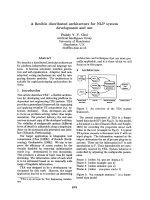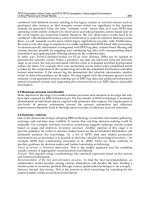Adamsen, Paul B. - Frameworks for Complex System Development [CRC Press 2000] Episode 1 Part 1 pdf
Bạn đang xem bản rút gọn của tài liệu. Xem và tải ngay bản đầy đủ của tài liệu tại đây (50.3 KB, 6 trang )
©2000 CRC Press LLC
chapter 1
Introduction
This book deals with the problem of the design and management of
complex
systems. Dommasch and Laudeman comment, “It is well to remember that
any fool can design a complex system to do a simple job, but it is something
else again to design a simple system to perform a complex task.”
2
In order to develop the simplest solution to a complex problem, the
problem must be well understood. Thus, a central concern in the development
of complex systems is understanding. This involves the ability to understand
the customer’s needs that are to be addressed by the system; to understand
the context in which the system will function; to understand the solution to
the problem as it is being developed; and finally to help the customer under-
stand his/her problem and its proposed solution. As systems continue to
become more complex, the problem of understanding becomes more acute.
The author’s background is spacecraft systems. Like many complex systems,
early spacecraft were relatively simple. However, especially after the advent
of the computer, spacecraft have become increasingly complex.
I. Is a Structured Approach Needed?
While acknowledging that many companies do employ a structured
approach to the development of their systems, many do not. Therefore, the
following are offered as suggestions as to why a structured approach to
complex system development is increasingly necessary.
Increasing Complexity
— First, as just mentioned, systems are becom-
ing increasingly complex. It used to be that the success of a new system
development activity often depended upon the competence of the system
engineer who knew everything about it. However, the days of those kinds
of efforts being successful are numbered. Systems are becoming so complex
that it is increasingly difficult to find any one person who is able to “keep
it all in his head.”
2
Dommasch, Daniel O. and Charles W. Laudeman,
Principles Underlying Systems Engineering
,
New York: Pitman Publishing, 1962, p. 393.
©2000 CRC Press LLC
Personnel Longevity
— A second reason has to do with the longevity
of people. The explosion of complexity, in large part, has taken place within
the lifetime of the last generation. As those people who grew up with the
industries now producing complex systems retire or otherwise leave the
industries, who is left to “pick up the ball”? New people, who did not
have the opportunity to learn the systems when they were relatively sim-
ple. These new people are left with the task of “picking up the ball,” not
at the size of a snowflake, but after a system has snowballed to often
avalanche-creating proportions. How are these people going to be able to
do this effectively?
Workforce Discontinuities
— Third, long careers in the same organi-
zation are becoming increasingly rare. Companies continue to merge, divest,
reorganize, acquire, consolidate, relocate, globalize, centralize, and so on.
Likewise, employees are becoming increasingly mobile, moving from one
company to another every several years. This causes an instability and
discontinuity in the workforce and therefore also on the development pro-
grams of which they are a part.
Intense Competition
— Fourth, intense competition and limited finan-
cial resources are putting enormous pressure on development programs to
reduce cost and cycle time. In order to remain competitive, these programs
must be executed in an increasingly efficient manner.
This is certainly not an exhaustive list, but these things do identify a
need to develop effective ways of dealing with the dynamics of a changing
environment. Clearly there are many elements to an effective strategy of
dealing with these and other pertinent issues. A central element of an effec-
tive strategy must include effective structuring of complex system develop-
ment activities.
II. Technical and Managerial — Integration is Essential
The design and management of complex systems involves the execution of
technical activities (e.g., requirements development, design, analysis, inte-
gration, verification, trade analyses, etc.) together with managerial activities
(e.g., configuration management, risk management, etc.). Because of the
necessary connection between them, these two sets of activities must be
integrated. But how should this be done? The approach discussed herein
involves clearly defining what the system development process is in terms
of the technical activities, and then using it to develop the logical connection
between the managerial and technical activities.
III. Motivation
Why study the topic of complex system design and management? The author
concurs wholeheartedly with Wymore, who comments:
©2000 CRC Press LLC
Every author has several motivations for writing, and
authors of technical books always have, as one moti-
vation, the personal need to understand; that is, they
write because they want to learn, or to understand a
phenomenon, or to think through a set of ideas.”
3
Most anyone who has been involved in the development of a complex
system has been struck by the amount of chaos that can develop so quickly.
Requirements are not communicated to the right people. Sufficient resources
are not available when they are needed. The customer does not know exactly
what he wants or needs, thereby causing an instability in the top-level
requirements. Heritage hardware and software bid in the proposal do not
support the interfaces of the new system or perform to the levels required.
Back-of-the-envelope analyses and engineering judgment do not agree with
current, more detailed analyses, thus invalidating previous assumptions.
The list could go on and on. It is this problem of controlling the chaos in
complex system development that inspired the author’s fascination.
IV. Objectives
A central objective of this book is to develop a generalized approach to
system development, such that the chaos which inevitably ensues can be
controlled. More specifically, key objectives include:
• Developing an overarching generalized process that integrates all
technical and managerial activities, that is applicable to all develop-
ment phases from conceptual to detail design, and that is applicable
to all levels of the design from top-level system to the lowest levels
of the system hierarchy;
• Defining the System Development Framework (SDF) in sufficient
detail so as to enable its implementation in the real world;
• Deriving a set of principles that serve to guide the person or teams
involved in complex system development;
• Laying the foundation necessary to accurately model the System
Development process;
• Clarifying where in the process iteration occurs and why; and
• Clarifying how functional decomposition is performed and its neces-
sary relationship to implementation. This involves understanding the
relationship between the “what” provided in specifications and the
“how” developed in the implementation.
3
Wymore, Wayne A.,
A Mathematical Theory of Systems Engineering — The Elements
, New York:
John Wiley and Sons, 1967, p. v.
©2000 CRC Press LLC
V. Key Questions
When setting up a program, the management team faces several important
decisions that can have a significant impact on the performance of the con-
tract. Some of these include:
• How should information flow and who is responsible for which
interfaces?
• What are the technical activities and how should they be ordered?
• How should the managerial aspects of system development be struc-
tured?
• How should the technical and managerial activities be coupled?
These questions are addressed in this book.
VI. “System” Defined in the Literature
Since the main subject of this book has to do with the development of
complex systems, it is necessary to discuss how the term is used herein. Hall
says, “Systems Engineering is probably not amenable to a clear, sharp, one
sentence definition.”
4
There are, however, several definitions found in the
current literature, and Hall offers his own: “A system is a set of objects with
relationships between the objects and between their attributes.”
5
Dommasch
and Laudeman define “system” as follows:
A complete system is any complex of equipment, hu-
man beings, and interrelating logic designed to per-
form a given task, regardless of how complex the task
may be. Logically, very large or complicated systems
are broken into subsystems, to be fitted together like
blocks to form the entire or total system.
6
In his 1991 work, Rechtin defines a system as “a collection of things working
together to produce something greater. . . . A system has the further property
that it is unbounded — each system is inherently a part of a still larger
system.”
7
He continues:
1. A system is a complex set of dissimilar elements or parts so connected
or related as to form an organic whole.
4
Hall, Arthur D.,
A Methodology For Systems Engineering
, Princeton, NJ: D. Van Nostrand, 1962, p. 4.
5
Ibid.
, p. 60.
6
Dommasch and Laudeman (1962), p. 182.
7
Rechtin, Eberhardt,
Systems Architecting: Creating and Building Complex Systems
, Englewood
Cliffs: Prentice-Hall, 1991, p. 1.
©2000 CRC Press LLC
2. The whole is greater in some sense than the sum of the parts, that is,
the system has properties beyond those of the parts. Indeed, the
purpose of building systems is to gain those properties.
8
Rechtin with Maier suggest, “A system is a collection of different things
which together produce results unachievable by themselves alone. The value
added by systems is in the relationships of their elements.”
9
Chase
10
, Wymore
(1967)
11
, Ellis and Ludwig
12
, and Minds
13
define a system as essentially “any-
thing that performs work on an input in order to generate an output.”
VII. Working Definition of “System”
There is overlap between the physical system being developed and the
processes used to effect the development. In the context of product devel-
opment, Krishnan et. al. suggest that the product development process
involves the
. . . transformation of input information about custom-
er needs and market opportunities into output infor-
mation which corresponds to manufacturable designs.
. . . Individual development activities are themselves
viewed as information processors, receiving input in-
formation from their preceding activities, and trans-
forming this input information into a form suitable for
subsequent activities.
14
This is an excellent summary statement as to how each element of the
development process is viewed, as well as how each element of the system
itself is viewed in this book. Any complex system composes several sub-
systems, which, in turn, compose more sub-subsystems. Each of these “sys-
tems” receives input, does work on that input, and then generates an output.
This is an important point because it suggests that any process applicable
to the development of a system must, by this definition, be applicable to the
development of its subsystems. This principle lays the foundation for a
modular approach to the process definition.
8
Ibid.
, p. 28.
9
Rechtin, Eberhardt and Mark W. Maier,
The Art of Systems Architecting
, Boca Raton, FL: CRC
Press, 1997, p. 21.
10
Chase, Wilton P.,
Management of System Engineering
, New York: John Wiley & Sons, 1974, p. 54.
11
Wymore (1967), p. 21.
12
Ellis, David O., Fred J. Ludwig,
Systems Philosophy
, Englewood Cliffs: Prentice-Hall, 1962, p. 3.
13
Minds, Kevin S., “System Engineering The People System,” NCOSE 1995, P066.
14
Krishnan, Viswanathan, Steven D. Eppinger, Daniel E. Whitney, “A Model-Based Framework
to Overlap Product Development Activities,”
Management Science
, Vol. 43, No. 4, pp. 437-451,
April 1997.
©2000 CRC Press LLC
For this book, the term “system” will be defined as “any entity within
prescribed boundaries that performs work on an input in order to generate
an output.” Note further that a system’s external interfaces consist of those
entities or realities that impinge upon the prescribed boundaries. The system
exists within a definable physical space and within a specific timeframe.









